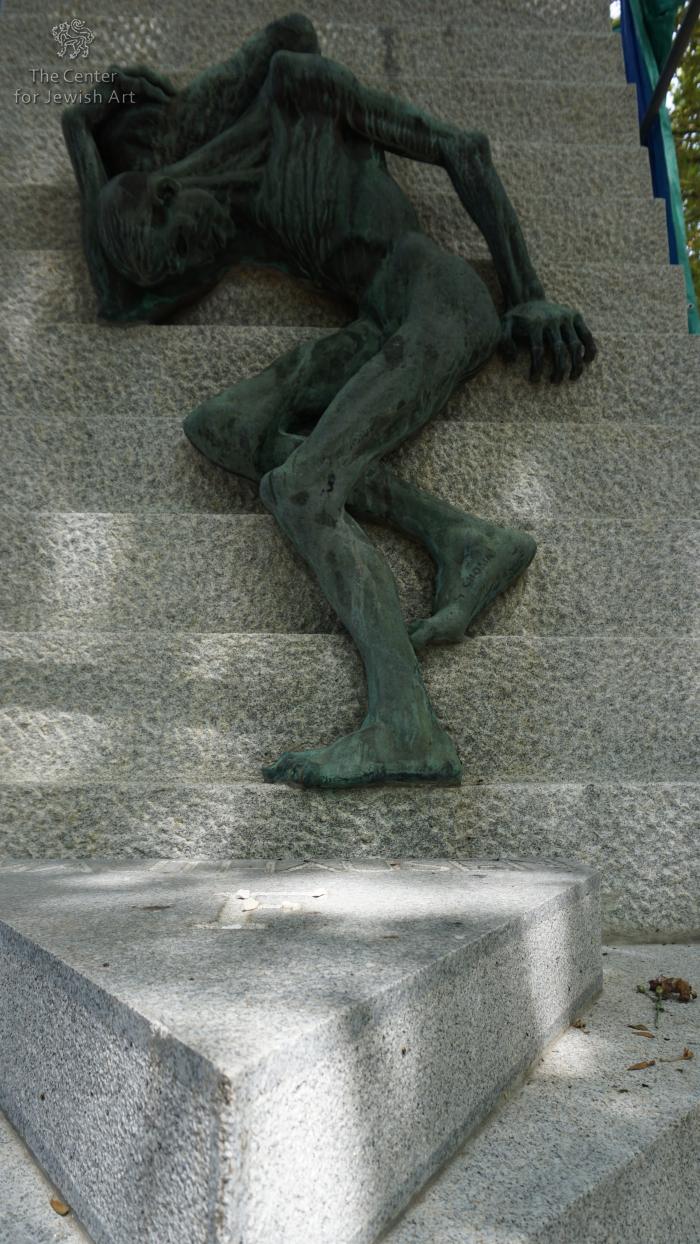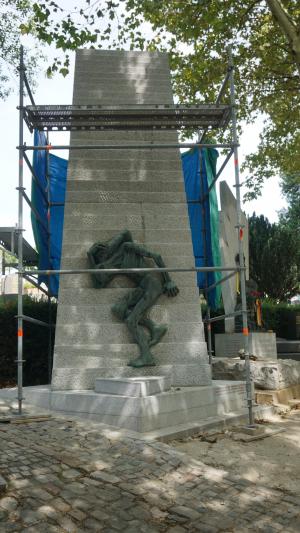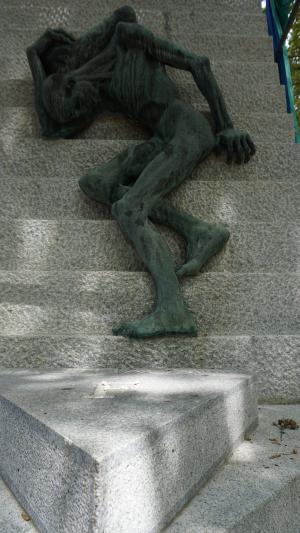Obj. ID: 43342
Comparative Material & Miscellaneous Mauthausen Monument in Père Lachaise Cemetery in Paris, France, 1958
To the main object: Jewish tombstones at Père Lachaise Cemetery in Paris, France

Who is Commemorated?
Victims of Mauthausen concentration camp
Description
The monument is located near a corner in section 97 of the cemetery in an area of other collective monuments. The tall granite architecture stands above many of the nearby tombs, but the design relates to other earlier monuments in Père Lachaise cemetery. The architecture and sculpture are two important parts that create a unified fact-inspired narrative. The stone setting is intended as an active element in the memorial's storytelling. The steep-stepped granite tower represents the infamous Stairs of Death at the Mauthausen granite quarry where prisoners were forced to climb carrying granite blocks weighing 25 kilos and more, and where they often plummeted to their deaths. The granite for the monument itself was brought from the quarry and stands like a holy relic, a witness to suffering.
The bronze sculpture by Gérard Choain attached to the stone represents an emaciated prisoner who carries a heavy stone to the top of the 186 Stairs of Death. While this explicitly recalls the life and death daily struggle of prisoners who worked in the quarry, the posture and profile of Choain's figure also has a distinguished artistic pedigree. Any Frenchman immediately sees the resemblance to Auguste Rodin's great statue of The Shade (also known as The Slave) of 1886. This was the figure used in triplicate atop Rodin's massive Gates of Hell, which in many other contexts has greatly influenced the imagery of Holocaust suffering and death. There is also a close connection to Michelangelo's unfinished Slaves (also known as The Prisoners) intended for the Tomb of Pope Julius II, and since 1909 on view at the Galleria dell'Accademia in Florence.
The stepped monument sits on a triangular stone base that evokes the triangles worn to identify and differentiate different groups of prisoners in the camps.
Inscription
On the bronze sculpture:
G. CHOAIN / M. 1958
M. HOHWILLER - FONDEUR - PARIS
On the right side of monument:
MAUTHAUSEN
Camp
D’extermination
Hitlérien
12,500
Français
y furent
déportes
10,000
y furent
extermines
Les 186 marches
de l'escalier de
la carrière
furent le cal
vaire de ceux
qui devaient
sous les coups
des SS les gravir
en portant de
lourdes pierres.
Ce monument
perpétue leur
mémoire et leur
combat pour
l’Independence
Française.
SOUVENEZ VOUS
Translation: Mauthausen / Nazi extermination camp / 12500 French were deported there / 10000 were exterminated there / The 186 steps of the quarry staircase were the ordeal of those who, under the blows of the SS, had to climb them carrying heavy stones. / This monument perpetuates their memory and their struggle for French independence. / Remember!
On the left side of monument:
MAUTHAUSEN
Camp
d'extermination
Hitlérien
180,000
hommes et femmes
y furent
emprisonés
154,000
sont morts tortures gazes
fusilles pendus
Pour que leur
sacrifice contri
bue a barrer à
jamais la route
à l’oppression
et à ouvrir à
l’humanité la
voie d’un avenir
meilleur dans
l’amitié et dans
la faix entre les
peuples
SOUVENEZ VOUS
Translation: Mauthausen / Nazi extermination camp / 180,000 men and women were imprisoned / 154,000 died tortured, gassed, shot, hanged / For their sacrifice helps to forever block the road to oppression / and to open humanity towards a better future in friendship and in / peace between peoples. / Remember!
On the base of the monument:
Les données statistiques gravées sur cette pierre en 1958
correspondent aux évaluations de l’époque, elles ont été
rectifiées parles travaux de la recherche historique.
Amicale de Mauthausen
Paris 2013
Translation: The statistical data engraved on this stone in 1958 correspond to the evaluations of the time, they have been rectified by the work of historical research. / Mauthausen Association / Paris 2013
Commissioned by
Amicale de Mauthausen (Mauthausen Association).
sub-set tree:
On the left leg of the sculture:
G. CHOAIN / M. 1958
The monument is one of more than a dozen memorials erected in the Père Lachaise Cemetery commemorating victims of various Nazi concentration and death camps. These monuments have been erected by camp survivors, political organizations, and other associations beginning in 1949, when memorials to victims of Auschwitz-Birkenau (June) and the camp at Neuengamme (November) were dedicated.
The Mauthausen memorial monument was created by sculptor Gérard Choain (1906-1988), who himself was a wounded veteran and was a prisoner of war in German camps from 1939 to 1945. After the war, he created several memorial sculptures.
Most of the inmates and victims at Mauthausen were not Jewish and this is not a Holocaust Monument per se. Still, the memorial plays an important role in the development of Holocaust monuments and iconography. It is one of a group of works of the 1950s that focuses on the physical - even cadaverous - state of Holocaust victims, rather than idealizing them as healthy heroes and fighters. The inscriptions on the monument reflect the numbers of prisoners and victims believed at the time. Since then, research has provided more accurate information. An inscription added in 2003 on the base of the monument acknowledges that the numbers presented reflect the beliefs in 1958.
According to the U.S, Holocaust Memorial Museum, inmates and victims at Mauthausen included more than 37,000 non-Jewish Poles, nearly 23,000 Soviet civilians, between 6,200 and 8,650 Yugoslav civilians, approximately 6,300 Italians after September 1943 at least 4,000 Czechs and in 1944, 47 Allied military personnel (39 Dutchmen, 7 British soldiers, and 1 US soldier), all of them agents of the British Secret Operations Executive. In addition to French Resistance fighters, thousands of Spanish Republicans were also brought to Mauthausen. About 29,000 Jews are believed to have been held at Mauthausen, mostly in the latter years of the war.
The Mauthausen site was one of the first to be memorialized after World War II, and subsequently became the site for dozens of monuments. Ashes and relics from Mauthausen were also incorporated in many other monuments in other locations, such as the extreme modernist Monumento in onore dei caduti nei campi di sterminio nazisti located outside Cimitero Monumentale di Milano designed by the architectural firm BBPR (Lodovico Barbiano di Belgiojoso, Enrico Peressutti, Ernesto Nathan Rogers), one of whose founders, Gianluigi Banfi, was killed at Mauthausen.
In France, a coalition of Resistance fighters, Jewish deportees, and other victims of Nazi crimes worked to create a public narrative of suffering and heroism balancing the themes of the Gaullist politics of memory of the 1950s with those of the political left. Meanwhile, the official Jewish Community began in the 1940s to place plaques in synagogues remembering Jewish victims under the heading "Morts pour la France," (Fallen for France), even though many victims died through the complicity of French authorities and police.
Gruber, Samuel D. “Paris: The Mauthausen Concentration Camp Monument at Père Lachaise Cemetery,” Samuel Gruber’s Jewish Art & Monuments. August 26, 2018, https://samgrubersjewishartmonuments.blogspot.com/2018/08/paris-mauthausen-concentration-camp.html (accessed December 22, 2021)
Nord, Philip. After the Deportation: Memory Battles in Postwar France (Cambridge: Cambridge University Press, 2020)










